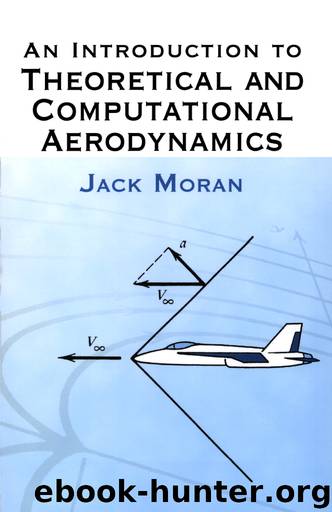An Introduction to Theoretical and Computational Aerodynamics by Jack Moran

Author:Jack Moran
Language: eng
Format: epub
Publisher: INscribe Digital
Published: 1984-04-04T05:00:00+00:00
FIG. 7.16. Comparison of measured pressure distributions on a circular cylinder with potential-flow result. Reprinted with permission from Ref [6].
This fact is, as noted, useful in locating the separation point. For example, in Thwaites’s method discussed above, laminar separation can be predicted to occur when l(λ) vanishes, since l is defined in equation 7-39 to be proportional to the wall shear stress. According to the correlation formulas 7-43, this will happen when λ = – 0.0842. A similar criterion is not possible in Head’s method for turbulent boundary layers, however, since the skin friction given by the Ludwieg-Tillman skin-friction formula (7-65) can never vanish. According to Kline et al [13], one may predict turbulent separation by examining the development of the shape factor H, which is typically about 2.4 at the start of separation.8
One immediate consequence of boundary-layer separation is that the boundary layer is no longer “thin” once it separates, in the sense that the characteristic length in the x direction is then as small as is that for changes in the y direction. The pressure in the external flow can no longer be calculated with the viscosity of the fluid ignored completely; you must consider the interaction of the external flow and the boundary layer. The direction of the change in pressure from its inviscid value is that of the displacement effect of an attached boundary layer. The magnitude of the change can be considerably larger, since separation effectively entails a large displacement thickness; see Fig. 7.16, which compares the pressure distributions observed on a circular cylinder at various Reynolds number with theoretical results obtained under the assumption of irrotational inviscid flow. Thus, boundary-layer separation substantially increases form drag.
To summarize, if the pressure increases too rapidly in the direction of the external flow, the flow within the boundary layer may back up, which creates all sorts of aerodynamic problems. Even if it does not separate the boundary layer, a positive pressure gradient will substantially thicken it, and alter the pressure distribution on the body in such a way as to produce drag. Also, as noted previously, a positive dp/dx destabilizes a laminar boundary layer; transition to turbulence is often fixed by the location of the minimum pressure point on the surface as much as by the Reynolds number. Positive pressure gradients are therefore called adverse pressure gradients, and their control is a major goal of aerodynamic design. A streamlined body is one for which the streamlines closely follow the body contour, meaning that separation is minimized so as to maximize performance.
Download
This site does not store any files on its server. We only index and link to content provided by other sites. Please contact the content providers to delete copyright contents if any and email us, we'll remove relevant links or contents immediately.
Tools of Titans by Timothy Ferriss(7789)
Turbulence by E. J. Noyes(7689)
Astrophysics for People in a Hurry by Neil DeGrasse Tyson(4997)
Secrets of Antigravity Propulsion: Tesla, UFOs, and Classified Aerospace Technology by Ph.D. Paul A. Laviolette(4972)
Design of Trajectory Optimization Approach for Space Maneuver Vehicle Skip Entry Problems by Runqi Chai & Al Savvaris & Antonios Tsourdos & Senchun Chai(4837)
Room 212 by Kate Stewart(4728)
Pale Blue Dot by Carl Sagan(4610)
The David Icke Guide to the Global Conspiracy (and how to end it) by David Icke(4374)
A Journey Through Divination and Astronomy by Publishing Pottermore(4245)
Apollo 8 by Jeffrey Kluger(3507)
Goodbye Paradise(3438)
Losing the Nobel Prize by Brian Keating(3424)
COSMOS by Carl Sagan(3343)
The Five People You Meet in Heaven by Mitch Albom(3330)
Brief Answers to the Big Questions by Stephen Hawking(3237)
How to Read Water: Clues and Patterns from Puddles to the Sea (Natural Navigation) by Tristan Gooley(3235)
The Order of Time by Carlo Rovelli(3071)
How to Read Nature by Tristan Gooley(3070)
A Brief History of Time by Stephen Hawking(2817)
